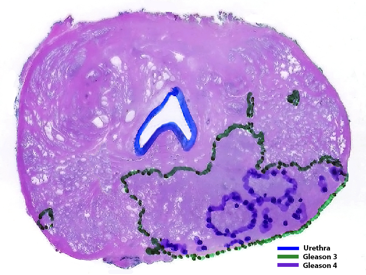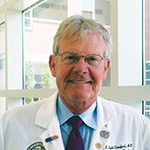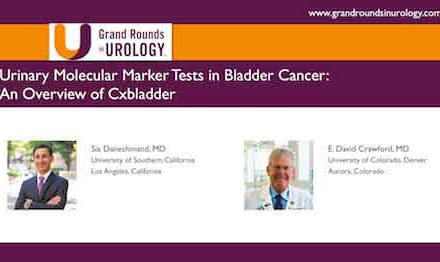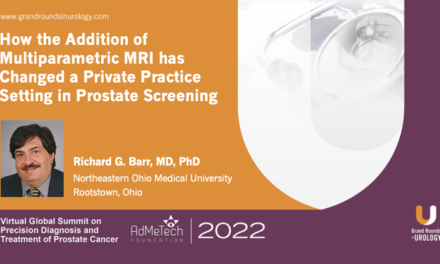
E. David Crawford, MD asked expert Francisco G. La Rosa, MD, FACS about reporting Gleason grades.
Question by E. David Crawford, MD: Dr. La Rosa, there seems to be some variation on how prostate biopsies are reported. My recollection of the Gleason system is that the most predominant pattern is reported. Please explain how a biopsy may be reported as a Gleason eight whereas the tumor may be a Gleason seven (i.e. 3+4).
Answer by Francisco G. La Rosa: This apparent discrepancy may be due to two different scenarios: (1) Since prostate cancers are usually multifocal, TRUS biopsies may be targeting different tumors, one may be 4 + 4 = 8 and another nearby tumor may be a mixture of Gleason grades 3 and 4. The only way to determine that these are different tumors is with examination of a whole mount prostatectomy section. (2) If the tumor is unifocal and TRUS biopsies show differences in Gleason grades, this is due to the heterogeneity of prostate tumors, which usually show areas with only one Gleason grade (i.e. Gleason 4 + 4 = 8) and other areas with a mixture of other grades (i.e. 4+3 or 3+4). This is illustrated in the figure below, which shows one section of a whole mount prostatectomy specimen, in which Gleason grades of the tumor have been outlined with green dots for Gleason grade 3 and purple for Gleason grade 4. Depending on the area of the tumor targeted by the needle biopsy, we may obtain different Gleason grade combinations of a Gleason 3 + 4 = 7 tumor.

Prostatic adenocarcinoma Gleason grade 3 + 4 = 7 (Gleason grade 4 is ~20%)
Depending on the targeted area, TRUS biopsies will sample different mixed combinations
of Gleason grades. The final Gleason grade will be determined on the whole mount
prostatectomy section.
ABOUT THE AUTHOR
Francisco G. La Rosa, MD, FCAP, serves as an Associate Professor in the Department of Pathology at the University of Colorado Anschutz Medical Campus and is a distinguished member of the University of Colorado Cancer Center. He originally graduated as an M.D. in Lima, Peru, with Residency in Clinical Pathology, followed by Residency in Anatomic and Clinical Pathology at the “University of Colorado.” He is Board Certified in anatomic and clinical pathology, and specializes in genitourinary, renal, and heart pathology. He is also recognized as an expert in pathology informatics.
Dr. La Rosa actively engages in clinical practice, research, and education with over 100 publications in refereed journals. His primary hobbies include photography and videography, both of which he has utilized for educational purposes by creating several websites dedicated to the teaching of pathology.
Dr. La Rosa holds memberships in several national and international organizations, including the College of American Pathologists, American Urological Association, Peruvian American Medical Association, Catholic Medical Association and Association for Pathology Informatics. His research involvement extends to collaboration on various research grants in genitourinary pathology, and he serves as a member and study coordinator at the Southwest Oncology Group (SWOG), Genitourinary Committee. Most notably, he collaborates closely with Dr. E. David Crawford and his team on cutting-edge technology for diagnosing and treating prostate and urinary cancers. As a faculty member of Grand Rounds in Urology, he actively participates in various innovative educational activities within the field of urology.
As a graduate from the Teaching Scholar Program at the University of Colorado, Dr. La Rosa imparts his knowledge to medical students, as well as pathology residents and fellows. His commitment to excellence in teaching has earned him several recognitions.
Beyond national borders, Dr. La Rosa is recognized as an Honorary Professor at the Medical School Hipolito Unanue of the National University Federico Villarreal in Lima, Peru. He also serves as the co-founder and current Administrator of the Asociación Iberoamericana de Telesalud y Telemedicina (AITT) and holds the position of founder and Editor-in-Chief of the international journal Revista de la AITT (ISSN 2411-3840). The mission of these endeavors is to promote and coordinate programs and activities in telehealth and telemedicine among Latin American countries. Additionally, he serves on several international scientific committees and editorial boards of scientific journals, further contributing to the global advancement of pathology.






